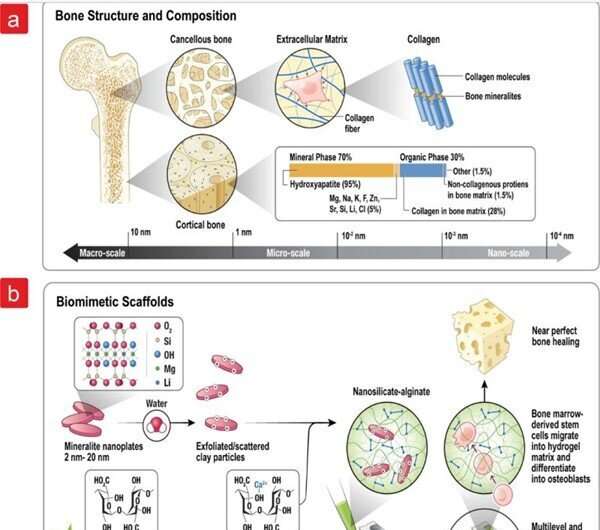This article has been reviewed according to Science X's editorial process and policies. Editors have highlighted the following attributes while ensuring the content's credibility:
fact-checked
peer-reviewed publication
trusted source
proofread
Research team achieves near-perfect bone healing with new multi-leveled scaffold

A team at DTU Health Tech, led by Associate Professor Alireza Dolatshahi-Pirouz, has made a leap forward in tissue regeneration by creating a multi-leveled scaffold that encompasses properties of native bone on both the nano, micro and macro scale.
In a recent paper in the ACS Applied Materials and Interfaces journal, the researchers describe the discovery of near-perfect bone healing in a rat model after only eight weeks, using their scaffold—and without using growth factors.
In addition, the scaffold is combinatorial and can simultaneously release several essential bone minerals while covering mechanical properties, i.e., the compressive strength needed to match those of cancellous human bone.
"The implications of these results are enormous, and our aim is now to lower the healing time to 4 weeks and reach almost instant tissue regeneration without using endocrine factors and cells. We will also be looking into whether this could be used for other tissues," says Alireza Dolatshahi-Pirous, an associate professor at DTU Health Tech and corresponding author.
FDA-approved materials
By incorporating stem cells, more bioactive components such as collagen and gelatin, coatings that increase native cell migration into the scaffolds, and electromagnetic stimulation, it could pave the way for rapid healing of soldiers suffering from critical musculoskeletal fractures or civilians suffering from traumatic injuries. These people are frequently hospitalized for months, with a long road to recovery.
Notably, this new scaffold was made primarily from glass, alginate and nano-silicate—already FDA-approved materials. Thanks to its FDA-approved status, hurdles for regulatory clearance are significantly reduced. This means the scaffold can be used more confidently and efficiently in clinical settings, accelerating development and improving patient outcomes.
"I believe this discovery could be a game-changer in the field of tissue regeneration, and I hope to see this technology being used to help those in need," says Alireza Dolatshahi-Pirouz.
More information: Mozhgan Keshavarz et al, Multi-leveled Nanosilicate Implants Can Facilitate Near-Perfect Bone Healing, ACS Applied Materials & Interfaces (2023). DOI: 10.1021/acsami.3c01717


















